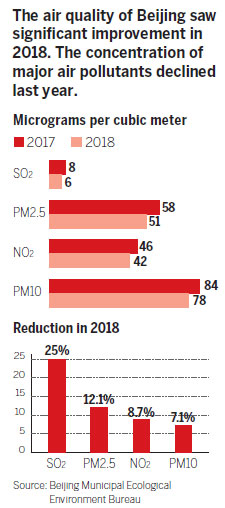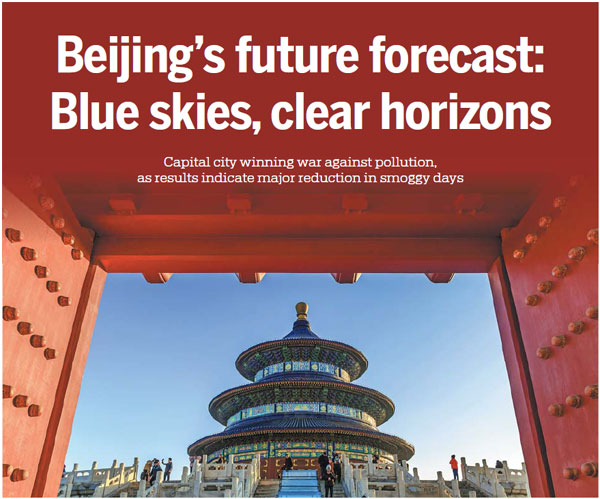Beijing's future forecast: Blue skies, clear horizons
Capital city winning war against pollution, as results indicate major reduction in smoggy days
Yun Duo and her family were looking forward to spending this year's traditional Spring Festival in Beijing - but they were worried about one issue: the capital city's reputation for polluted air, especially in the winter.
They needn't have worried.
"Only when it was snowing did the sky turn dusky; the rest of the time, it was blue. The temperature is low, but we were never bothered by air pollution during the seven-day stay," said Yun, who comes from Shenzhen, a southern city bordering Hong Kong.
"We have heard many stories about the serious air pollution in Beijing, but the personal experience is pretty different. Maybe we are lucky," Yun said with a smile.
In fact, her experience is not unique. Statistics indicate that Beijing's air quality has steadily - and dramatically - improved in recent years, thanks to the government's efforts to restore the blue sky and its three-year action plan to guide the tough campaign.

According to the Beijing Municipal Environmental Monitoring Center, the air quality of Beijing was sound during the public holiday of the Chinese Lunar New Year, which started on Feb 4.
During the week-long holiday, the air quality was rated as "excellent", which means the Air Quality Index stands between 1 and 50, for four days. It was measured as "good", a level between 51 and 100, for two days. Only one day was rated as "slightly polluted".
By comparison, only three days were rated as "good" or "excellent" during the Spring Festival holidays in Beijing last year, according to the official figure.
The Air Quality Index measures the average density of PM2.5 - the particulate matter with a diameter of less than 2.5 micrometers in the air. On average, the measurement was recorded as 38 micrograms per cubic meter from Feb 4 to 9, down 51 percent from 78 micrograms of the corresponding period last year, the figures show.
The good air quality during the Lunar New Year holiday in Beijing was an encouraging sequence, and an example of the less polluted days seen in the capital in the past year.
The Beijing Municipal Ecological Environment Bureau released a report on the city's air pollution in early January, indicating that last year, all four major pollutants in the capital city's air dropped.
The average density of PM2.5 was cut 12.1 percent year-on-year to 51 micrograms per cubic meter in 2018, the figures show.
The highest level of PM2.5 on a daily average basis stood at 244 micrograms per cubic meter in 2018, which was down 46.3 percent from a year earlier, said Liu Baoxian, deputy director of the monitoring center. He noted that the few heavily polluted days that did take place never lasted more than three consecutive days at any time last year, the first time that's happened since monitoring started in the capital.
The average density of sulfur dioxide, nitrogen dioxide and PM10 - the other three major pollutants - dipped by 25 percent, 8.7 percent and 7.1 percent, to 6 micrograms, 42 micrograms and 78 micrograms per cubic meter.
As a whole, Beijing's air quality was rated "excellent" for 72 days in 2018 - six days more than a year before - and "good" for 155 days, accounting for 62.2 percent of the whole year. Correspondingly, the heavily polluted days - the highest level of AQI that stands at 300 or up - was shortened by nine days to a total of 15.
By contrast, there were 58 heavily polluted days in 2013, when the capital kicked off its battle against serious air pollution.
In September 2018, Beijing issued a three-year action plan to keep air pollution at bay, bringing benefits to human health and the area's beauty, as well as playing a role in mitigating the effects of climate change.
The action plan focuses on cutting PM2.5 and continuing to reduce the number of heavily polluted days.
The PM2.5 of the six major districts of Beijing was targeted at 52 micrograms per cubic meter, while that of some suburban areas should be held below 46 micrograms by the end of 2020, according to the plan.
Meanwhile, to cut the greenhouse effect, the emissions of nitrogen dioxide and the volatile organic compounds in 2020 are projected to be lessened by at least 30 percent from the levels of 2015. Heavily polluted days are expected to be cut at least 25 percent from the levels of 2015.
chenhong@chinadaily.com.cn
|
A staff member of the Beijing Municipal Environmental Monitoring Center checks automatic air quality equipment. Gan Nan / For China Daily Two police officers monitor a construction site in Beijing to control pollutant emissions in the air while a vehicle is cleaned. Wu Di / For China Daily A new type of sprinkler is used in Beijing to clean pollution from the air. Provided to China Daily |
|
Beijing's Temple of Heaven under a blue sky in winter of 2018. Provided to China Daily |
(China Daily 02/21/2019 page7)
















